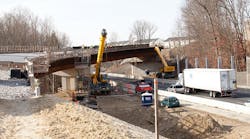The desire on the part of a wide variety of interest groups – from trucking companies to shippers and commuters – to improve roadway conditions and reduce traffic conditions are helping drive a number of recent efforts to rectify highway trust fund (HTF) monetary shortages.
“The infrastructure issue is not going away because it’s the most important – yet also most invisible – issue affecting the logistics industry today,” noted Kevin Smith, president and CEO of Sustainable Supply Chain Consulting during a panel discussion revolving around the 25th annual State of Logistics report released in Washington D.C. this week.As part of the panel’s nod to infrastructure issues, author Dan McNichol (in blue shirt in photo at right) shared his experiences conducting a 10,000 mile tour of U.S. roadways in a 1949 Hudson Hornet that he described as “old, rusty, and energy inefficient as America’s infrastructure.”
He noted for example driving on Route 2 in North Dakota: a two-lane road in the heart of the Bakken Shale oil producing region now carrying heavy truck traffic it was never designed to handle.
Yet with federal highway funding in decline, McNichol noted that state governments are trying to find ways on their own to beef up monies for transportation infrastructure needs – largely with mixed success.
“States are all looking at a variety of funding mechanisms, with more talk of ‘P3s’ among state government of state DOT agencies,” he said. “P3s are not a panacea to the funding issue but they do offer states more autonomy in transportation planning.”
P3s – short for public-private partnerships – are also getting more attention at the federal level as well, though use of such instruments are complicated, especially as many state legislatures have laws on the books forbidding them, stressed Rosalyn Wilson, author of the State of Logistics report and senior business analyst with Parsons.
“Only 33 states have passed laws allowing for the use of P3s,” she said.
Still, McNichol noted P3s are in heavy use in other countries, pointing in particular to Canada, where 25% of highway investment comes from P3 structures compared to just 2.3% in the U.S.
Yet main revenue mechanism of P3s – roadway tolling – is off-putting to many groups, particularly the trucking industry, which is why raising fuel taxes continues to get broad support among carriers and related groups.
For example, NATSO – the national association truck stops and travel plazas – is supporting efforts to raise the federal fuel tax and index it to inflation to keep the HTF solvent.
Currently 18 cents-a-gallon tax on gasoline and a 24 cents-a-gallon tax on diesel, the last increase in the federal fuel tax occurred in 1993, the group noted, and over the past two decades, inflation has eroded the buying power of the 18.4 cents federal fuel tax to just 11 cents.
“Raising the fuel tax is long overdue, and this is the right solution for both motorists and businesses,” noted NATSO President and CEO Lisa Mullings in a statement. “NATSO has long held that raising the fuel tax is the best option for generating critical transportation revenues.”




